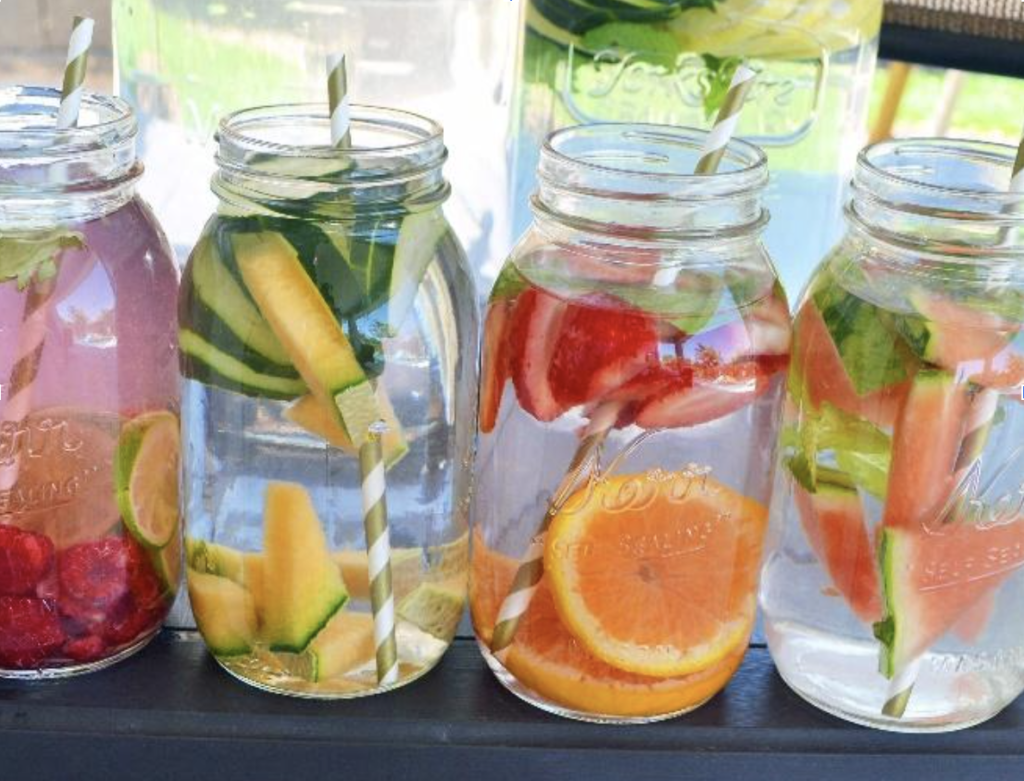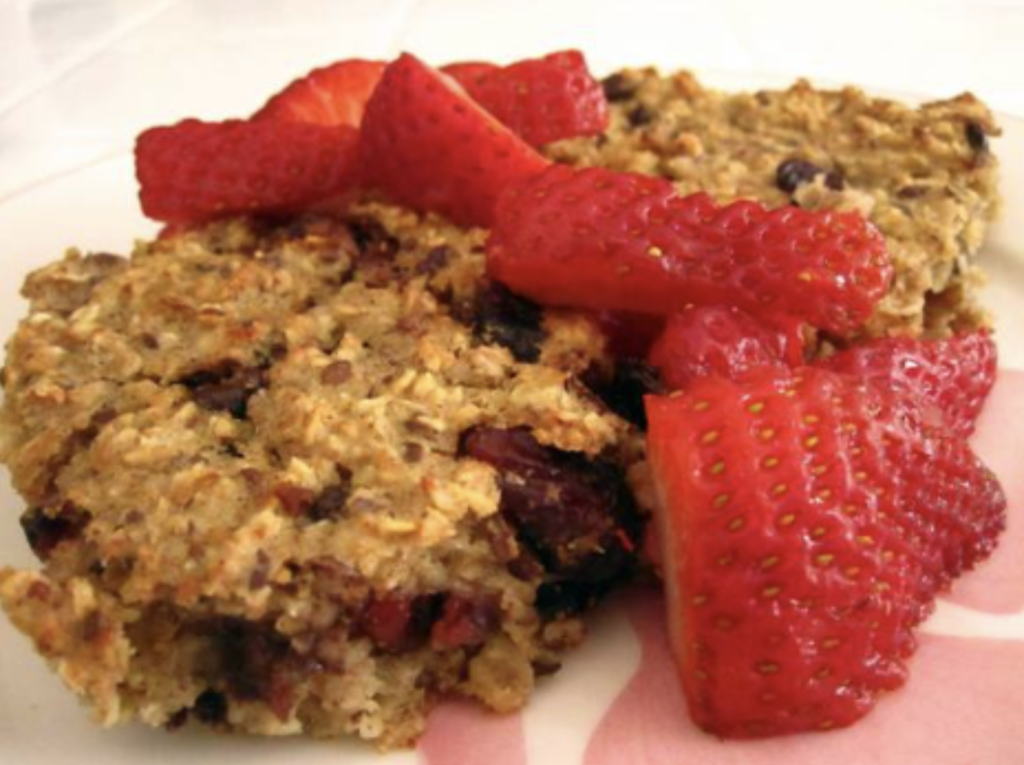Juices and Smoothies
Guide to Making Delicious Vegetable & Fruit Infusions, Juices, and Smoothies
Getting extra veggies and fruit into your diet gets easier if you consider drinking them. There are three main ways to sip on vegetables and fruits: infusion, juicing, and smoothies. The basic differences are with infusion, you add whole food to water to flavor it, and then you eat the veggie or fruit. Juicing pulls the liquid out of the food. In smoothies, you blend and drink the whole food. A special note- you’ll want to ensure all the food items you select for your concoctions are cleaned well and chemical free. The following overview is to help guide your creativity as you increase your daily vegetable and fruit nutrient intake.
INFUSION
Infusion involves soaking vegetables, fruits, herbs, and spices in water for a period of time to flavor the liquid. The vegetables and fruit are then eaten while enjoying the tasty water. This method also creates an eye-pleasing, healthy presentation. The benefit of the infusion is increased hydration, excellent taste, and low to no sugar.
Helpful guidelines:
- Use a large water glass or pitcher so you can see your creation.
- Fill the container with water, leaving room to add ingredients.
- Select one or a variety of items to soak in the water.
- Once you’ve created your desired combination, put the container into the refrigerator for at least 2 hours so flavors can emerge. Overnight really allows the flavors to strengthen.
- You can muddle (crush) some of your ingredients to help the flavors infuse more rapidly into the water. Leave some items whole to float for visual effect.
- Your concoction will last up to 3 days. If an ingredient gets to mushy before that time, simply remove it.
Choose one ingredient or a combination from the following categories, or experiment with other food items:
- Fruits: apples, berries, coconut, grapefruit, kiwi, lemons, limes, mango, oranges, peaches, pineapple, pomegranate, watermelon
- Herbs & Spices: basil, cinnamon, clove, dried hibiscus, fennel, ginger, lavender, lemongrass, mint (mint comes in interesting flavors: chocolate, pineapple), rose petals, rosemary, star anise
- Vegetables: cucumbers, jalapeno, colored bell peppers
Proven combinations:
- Apple and cinnamon
- Basil and strawberry
- Basil, kiwi and peach
- Basil and diced tomatoes
- Bell pepper, celery and tomatoes
- Bell pepper, cucumber and jalapeno (a little dab will do ya)
- Cucumber, lemon and mint
- Grapefruit and rosemary
- Lavender and lemon/lime
- Orange and fennel
- Pineapple, strawberry and sage
- Pineapple, ginger and mint
- Raspberry and chocolate mint
- Watermelon and basil or mint
Notes:
- Herbs, spices and flowers: you can contain these in cheesecloth or an infuser if you’d prefer they not float in your drink.
- Soft fruits and vegetables can be sliced thin, thick or in chunks.
- Firmer vegetables and fruits should be sliced thinly to release flavors.
- Fibrous herbs should be muddled (crushed) to release their flavorful oils.
JUICING
Juicing is a method that extracts the liquid portion of vegetables and fruits and leaves the important fiber behind. Even without the fiber, juice contains a good portion of the vitamins, minerals, and phytonutrients found in the whole food. Be aware that it also contains more “free” sugar than you might realize. Mainly because fiber sticks to some of the excess sugar and carries it out of the body.
Juice is best if you drink it within a couple of days. Refrigerate it shortly after juicing to avoid bacterial growth. Commercial products are often pasteurized, like milk, to destroy bacteria to give the juice a longer shelf life. But this may destroy some of the nutrients also.
Vegetable and fruit liquid is extracted with a juicer. The pulp comes out of one side of the machine and juice out the other. The leftover pulp is a good base for soup stock, or you can add it to your compost. If you let fresh juice “sit,” you might notice it separates into a thin liquid and something thicker on the bottom of the glass. The thick layer is a congregation of small pulp pieces. Simply stir and drink.
Why should you care about small or large pieces of pulp or fiber? Fiber is important to your intestinal health and movement. There are two forms of fiber soluble and insoluble. Neither are absorbed into the body as a nutrient, their job takes place in your gut. Adequate amounts of fiber in the diet prevent constipation, helps regulate blood sugar and cholesterol, are important for losing weight, lower your risk for heart disease, and even help slow aging.
Soluble fiber is sticky, allowing it to attach to excess dietary cholesterol and sugar in the intestinal tract and move them down the “pipe” and out of your body. When soluble fiber is mixed with adequate liquid in the digestive tract (another reason to stay hydrated), it forms a gel like substance. This makes you feel full quicker, so you want to eat less. It also bulks up your stool to the correct consistency to avoid diarrhea and constipation. Soluble fiber supports the good bacteria in the body, improving immunity. Soluble fiber lowers LDL cholesterol. Very little of the soluble fiber is lost during the juicing process.
Insoluble fiber, also known as roughage, is the pulp the juicer removes. It’s usually found in the skin or seeds of fruits and vegetables as well as grain products. It absorbs water to help move stool and toxins out of the digestive tract. It is known to help treat and prevent constipation and hemorrhoids.
By the way, women need 25 to 32 grams of fiber per day. Men need 30-38 grams per day. Always increase fiber intake slowly, meaning days, to avoid excess gas and bloating as your digestive tract and the bacteria it houses gets used to this healthy addition. Also, you need to drink plenty of fluids for the fiber to work effectively, at least 6-8 eight-ounce glasses of water or other healthy liquid daily.
Juicing is a gentle way for the body to absorb nutrients, putting little strain on the digestive tract. The juicer breaks down food, releasing vitamins, minerals, and phytonutrients. Most of the nutrients in the juice are readily and quickly absorbed into the body.
SMOOTHIES
Smoothies are the full-bodied, thicker versions of vegetable and fruit drinks that retain fiber and pulp. Smoothies can be used for occasional meal replacement or to add extra nutrition to your diet. You can hide a variety of vegetables in a smoothie for picky eaters. When combining vegetables and fruits, you want at least a two (veggie) to one (fruit) ratio. 3:1 is ideal.
Blending smoothies is a bit of an art to achieving the right taste, texture, and color. Consider the following suggestions to create a smooth and delicious drink with a wide variety of nutrients.
Common smoothie veggies: beets, broccoli, carrots, celery, cucumbers, greens, kale, pumpkin, romaine, spinach, squash, zucchini, etc.
Fruits: fruits are added for flavor, nutrition, and a hint of sweetness. Haven’t found a fruit yet that didn’t work well in a smoothie. Too much fruit, however, can send your blood sugar on an unwanted upward spiral, so go easy. Avocados and banana help create a creamier smoothie texture. Berries tend to be lower in fruit sugar, packed with antioxidants, and high in fiber.
Nut and Seed Milk: you can make a milkshake-style smoothie by using vegetarian milk as your base. Choose unsweetened to keep sugar content down. Avoid products that add carrageenan.
Raw nut Butter: not just for sandwiches and stuffing into celery. Nut butters are a great flavor and nutrient addition to smoothies. Experiment with almond, cashew, coconut, ginger, hazelnut, macadamia, pecan, pistachio, or walnut. Nuts keep you feeling full longer and support brain function. You don’t need to add more than a few tablespoons to each smoothie.
Seeds: seeds are high in fiber, vitamins, and minerals. Chia, flax, and hemp seeds are good sources of omega-3 oils, magnesium, potassium, and B vitamins. Chia and hemp seeds are complete proteins, meaning they supply all the essential amino acids your body requires daily. Other seeds that go well in smoothies include pumpkin, sesame, and sunflower.
Extra Special Other Ingredients: If you want to get adventurous with antioxidant superfoods, experiment with a little of the following: acai, cacao, Ceylon cinnamon, chlorella, dark chocolate (72% grade and above is considered medicinal), Indian gooseberries, maca, nutmeg, spirulina, sumac, and turmeric. Most of these are available in a convenient powdered form. Non-sweetened yogurt is also a good blending partner.
Smoothie blending hints:
- Creaminess- bananas, especially frozen ones. Avocado will surprise and delight you.
- Slush factor: add ice cubes or frozen fruit during the blending process.
- Thickener: oatmeal will thicken your smoothie and reduce your cholesterol level.
- Dates or raw honey: a little extra hint of sweetness. Soak the dates in water in your fridge overnight to make them easier to blend. Avoid giving raw honey to children two years old or younger.
- Canned or processed veggies and fruits: don’t bother. Most of their nutrients have been destroyed by processing. Use fresh or frozen instead.
- Cooled teas add interesting flavor profiles: green tea adds an anti-oxidant boost.
- Avoid adding oils to your smoothie they don’t blend well. Use them elsewhere.
Blending order: layering in your smoothie ingredients makes for a perfect flavor and texture experience.
- Add a portion of your liquid base into your blender first, usually half the amount needed in the recipe.
- Blend in any powdered ingredients, including protein powder. This avoids clumps and chalky texture.
- Add sweeteners if you’re using them: raw honey, dates, stevia, etc.
- Leafy greens: perfect timing to avoid chopped-up pieces of vegetables. Too early in the process and the metal blades may cause oxidation; too late and the mixture may be too thick to chop them up well. CookingLite.com recommends romaine, spinach, or swiss shard as sweeter greens and arugula, collard greens, and kale for earthier flavors. You can use up to 2 cups of greens per 16-20 ounce smoothie.
- Frozen or fresh vegetables and fruits: frozen foods will cool your smoothie down. Use around 1 cup per 16-20 ounce smoothie.
- Ice: add ice if you want your smoothie cold and thick, usually 5-10 cubes. Another trick is to freeze nut milk in ice cube trays. Ice-cold additions prevent the veggies and fruits from heating up during the blending process.
- Add the remainder of the liquid needed to complete the recipe.
- Blending time: blend long enough to chop up items into a smooth liquid blend for 30-60 seconds. Do not over-blend or you’ll warm up the ingredients into a not-so-delicious soup.
Recipes
Note- you can add protein powder to any of the following recipes
Coconut Greens
- 2 large handfuls of kale
- 1 cup of fresh or frozen strawberries or blueberries
- 1½ cups of coconut water
- 2 tablespoons of chia seeds
- 1 tsp of raw honey
Blend for 45-60 seconds until smooth. Do not over blend.
Golden Turmeric Smoothie
- 1 cup green tea
- 1 cup berries of your choice (such as blueberries, raspberries, cranberries)
- 1 tablespoon coconut oil
- 1/2 teaspoon each of ground turmeric and ginger
- 1 teaspoon ground flaxseed or chia seeds
- A little raw honey or stevia to sweeten
- Cold water if needed to thin
Blend all the ingredients for about 2 minutes and add water according to your desired consistency
Avocado Green Smoothie
- 1 banana, peeled, fresh or frozen
- ½ cup frozen (or fresh) mango
- ½ small or medium avocado
- 1 cup spinach or kale
- 1 ¼ cups almond milk (soy, oat, rice, coconut or hemp milk are also fine)
- ¼ cup plain Greek yogurt
- 2 tablespoons organic oats
Place all smoothie ingredients in your blender and blend till very smooth and creamy. Add a little more almond milk as needed, or a few ice cubes if you want it to be frostier.
Red Beet Smoothie
- 1 small apple, cored.
- 1 raw red beet, washed, peeled. Only use RAW beets.
- 1 handful berries, frozen
- 1 handful kale (can also use beet greens or spinach)
- ¼ cup pineapple, frozen (optional)
- ½ naval orange peeled
- ½ cup Ice
- ½ cup Iced water
- 1 tablespoon flax seed (optional)
Blend for 45-60 seconds until smooth. Do not over blend.




